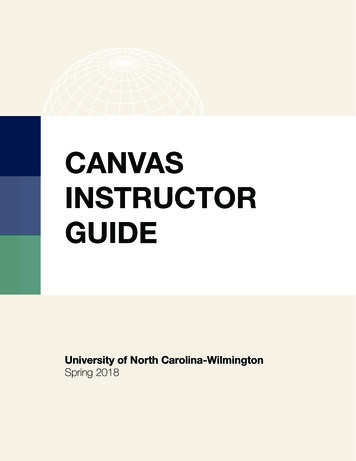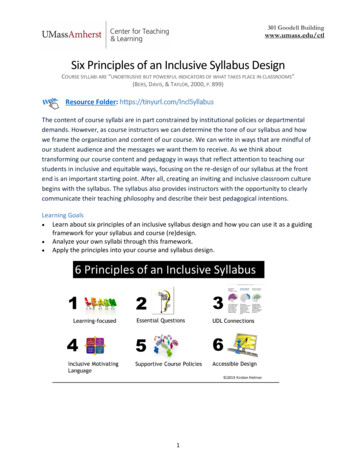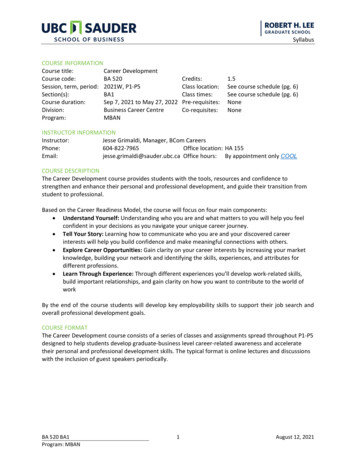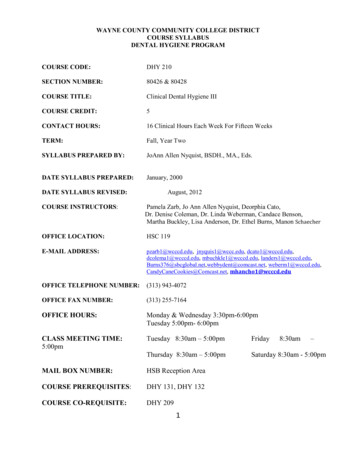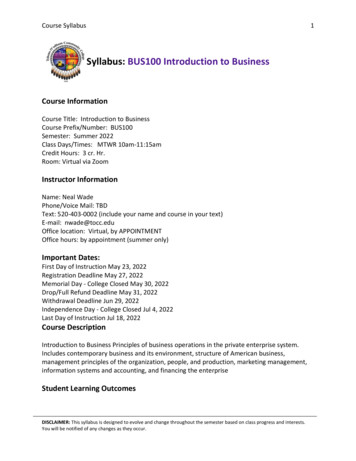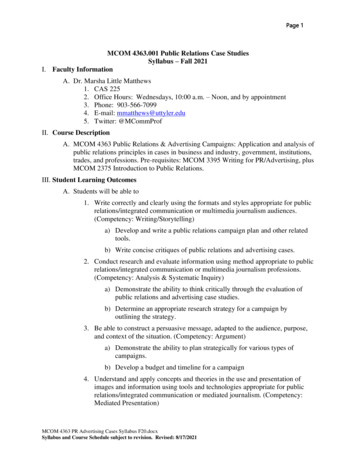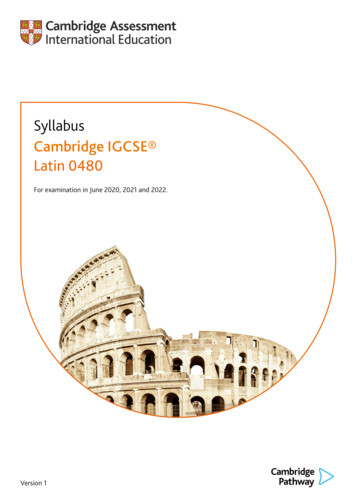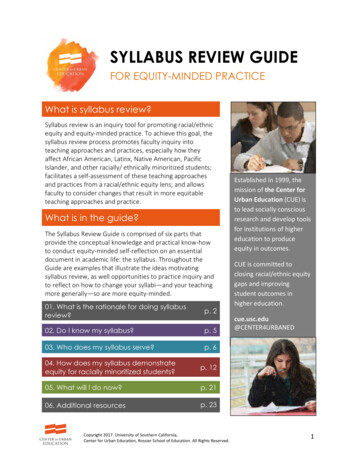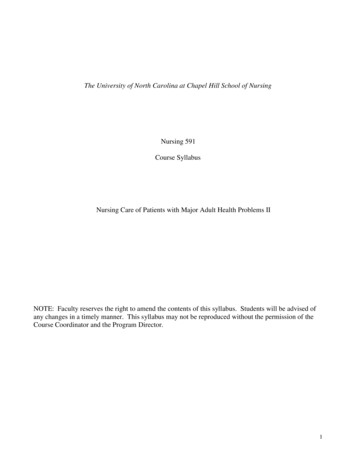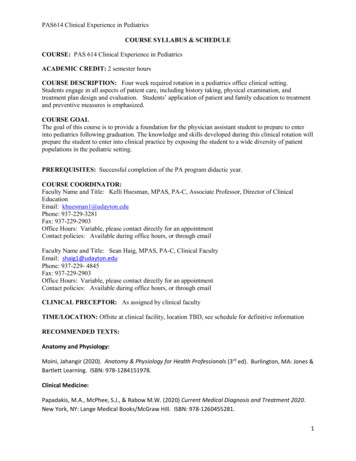
Transcription
PAS614 Clinical Experience in PediatricsCOURSE SYLLABUS & SCHEDULECOURSE: PAS 614 Clinical Experience in PediatricsACADEMIC CREDIT: 2 semester hoursCOURSE DESCRIPTION: Four week required rotation in a pediatrics office clinical setting.Students engage in all aspects of patient care, including history taking, physical examination, andtreatment plan design and evaluation. Students’ application of patient and family education to treatmentand preventive measures is emphasized.COURSE GOALThe goal of this course is to provide a foundation for the physician assistant student to prepare to enterinto pediatrics following graduation. The knowledge and skills developed during this clinical rotation willprepare the student to enter into clinical practice by exposing the student to a wide diversity of patientpopulations in the pediatric setting.PREREQUISITES: Successful completion of the PA program didactic year.COURSE COORDINATOR:Faculty Name and Title: Kelli Huesman, MPAS, PA-C, Associate Professor, Director of ClinicalEducationEmail: khuesman1@udayton.eduPhone: 937-229-3281Fax: 937-229-2903Office Hours: Variable, please contact directly for an appointmentContact policies: Available during office hours, or through emailFaculty Name and Title: Sean Haig, MPAS, PA-C, Clinical FacultyEmail: shaig1@udayton.eduPhone: 937-229- 4845Fax: 937-229-2903Office Hours: Variable, please contact directly for an appointmentContact policies: Available during office hours, or through emailCLINICAL PRECEPTOR: As assigned by clinical facultyTIME/LOCATION: Offsite at clinical facility, location TBD, see schedule for definitive informationRECOMMENDED TEXTS:Anatomy and Physiology:Moini, Jahangir (2020). Anatomy & Physiology for Health Professionals (3rd ed). Burlington, MA: Jones &Bartlett Learning. ISBN: 978-1284151978.Clinical Medicine:Papadakis, M.A., McPhee, S.J., & Rabow M.W. (2020) Current Medical Diagnosis and Treatment 2020.New York, NY: Lange Medical Books/McGraw Hill. ISBN: 978-1260455281.1
PAS614 Clinical Experience in PediatricsHistory and Physical Exam:Bickley, L (2016). Bates’ Guide to Physical Examination and History Taking (12th ed). Wolters KluwerHealth/Lippincott Williams & Wilkins. ISBN: 978-1469893419Labs:Desai, S., Katta, R. (2020). Clinician’s Guide to Laboratory Medicine (4th ed. Pocket). Houston, TX: MD2B.ISBN: 978-1937978105.Pharmacology:Brenner, G.M. & Stevens, C. (2017). Brenner and Stevens’ Pharmacology (5th ed). Philadelphia, PA:Elsevier. ISBN: 978-0323391665.Procedures:Clinical Procedures for Health Professionals (2017). Clinical Procedures for Health Professionals (1st ed).Philadelphia, PA: Jones & Bartlett. ISBN: 978-1284032413Radiology:Herring, W. (2020). Learning Radiology: Recognizing the Basics (4th ed). Philadelphia, PA:Mosby/Elsevier. ISBN: 978-0323567299.Study System:Sedrak, M, & Massey, S. (2011). Classroom to Clinic Study System: Personal Professor for ClinicalRotations and PANCE/PANRE Review. Philadelphia, PA: F.A. Davis Company. ISBN 978-0803623538.Brown, P.C., Roediger, H.L., & McDaniel, M.A. (2014). Make it Stick: The Science of Successful Learning.United States of America: Library of Congress Cataloging-in-Publication. ISBN: 978-0674729018.Research:Blessing, J.D. & Forister, J.G. (2020). Introduction to Research and Medical Literature for HealthProfessionals (5th ed.). Burlington, MA: Jones and Bartlett Learning. ISBN: 9781284153774.Dermatology:Habif, M.D., et al. (2013). Skin Disease Diagnosis and Treatment (4th ed.). Philadelphia, PA: Elsevier, Inc.ISBN: 978-0323442220.Orthopedics:Armstrong A.D. & Hubbard M.C. (2015). Essentials of Musculoskeletal Care (5th ed.). Rosemont, IL:AAOS. ISBN: 978-1625524157.Hoppenfeld, S. (1976). Physical Examination of the Spine & Extremities. Norwalk, CT: Appleton & Lange.ISBN: 978-0838578537.2
PAS614 Clinical Experience in PediatricsPediatrics:Marcdante, K.J. & Kliegman, R.M. (2019). Nelson Essentials of Pediatrics. Philadelphia, PA: Elsevier, Inc.ISBN: 978-0323511452.Emergency Medicine:Cline, D.M., et al. (2013). Tintinalli’s Emergency Medicine Just the Facts. China: McGraw Hill. ISBN: 9780071744416.Women’s Health:Casanova R, Chuang A, Goepfert AR, Hueppchen NA, Weiss PM. (2019) Beckmann and Ling's Obstetricsand Gynecology, (8th ed). Philadelphia: Wolters Kluwer. ISBN: 978-1496353092.Mental Health:Black, D.W., & Andreasen, N.C. (2014). Introductory Textbook of Psychiatry. 6th ed. Arlington, VA:American Psychiatric Publishing. ISBN 978-1-58562-470-6.OVERALL KNOWLEDGE, SKILLS AND ATTRIBUTES FOR ALL CLINICAL ROTATIONS(SCPEs) Knowledge: Understand and explain the etiologies, risk factors, underlying pathologic processes andepidemiology for the conditions encountered in clinical experience Demonstrates the appropriate history and physical exam skills, identifying normal andabnormal findings, and is able to counsel patients who present for acute, chronic andpreventative conditions Adequately formulates a differential diagnosis based on H&P findings and is able todevelop and carry out management plan based on the differential Select and interpret appropriate diagnostic or laboratory studies Manage presenting conditions to include understanding the indications, contraindications,side effects, interactions, and adverse reactions of pharmacological and nonpharmacologic agents Skills: Interpersonal and Communication Appropriately adapts communication style to the context of the individual patientinteraction, displaying respect, compassion and integrity, with the ability to showsensitivity and responsiveness to patients’ culture, age, gender and disabilities Accurately and adequately document information regarding care process for medical,legal, quality and financial purposes Clinical reasoning and problem solving Identifies the appropriate site of care for presenting conditions, including theidentification of emergent cases and those requiring referral and admission3
PAS614 Clinical Experience in Pediatrics Professionalism Work effectively with preceptor and other health care professionals to provide patientcentered care Promptly completes assigned tasks Consistently arrives at appointed time Recognizes personal learning needs and limitations, seeks to rectify them Accepts and uses constructive criticism from preceptor and staffLEARNING OUTCOMES SPECIFIC FOR PEDIATRICSINFANT Elicit a history for an infant (0-2 years old) health maintenance visit to include essential aspectssuch as nutrition, sleep, developmental milestones, and parent/caregiver concerns Perform a physical exam of an infant, adapting the exam in accordance to the infant’s age,including primitive reflexes and observation of developmental milestones, when able Provide anticipatory guidance to the parent/caregiver of an infant regarding nutrition, sleep,safety, and parent/caregiver well-being and support Recommend age-appropriate screening for infants, including development and autism screening,anemia and lead testing, and oral health screeningCHILD Elicit a history for a child (3-11 years old) health maintenance visit to include essential aspectssuch as nutrition, sleep, behavior, school performance, activity, and parent/caregiver concerns Perform a physical exam of a child, adapting the exam in accordance to the child’s age anddevelopmental stage Provide anticipatory guidance to the child and parent/caregiver regarding nutrition, sleep, safety,physical activity, screen time, and peer and family relationships Recommend age-appropriate screening for children, including vision, hearing, and dyslipidemiascreeningADOLESCENT Obtain the essential elements of a health maintenance visit of an adolescent (12-18 years old), toinclude history and physical examination, utilizing the HEADDSS mnemonic, preferably with thepatient separate from his/her parent/caregiver Identify Tanner stage on physical exam, and discuss pubertal changes with a pre-adolescent oradolescent patient Provide anticipatory guidance to the adolescent patient regarding nutrition, sleep, safety, physicalactivity, screen time, risky behaviors, and peer and family relationships Recommend age-appropriate screening for adolescents, including vision, hearing, dyslipidemia,and depression screening Sensitively discuss matters of minor consent and confidentiality with an adolescent patientGENERAL Recommend age-appropriate immunizations for infants, children and adolescents, and addressparent/caregiver concerns regarding vaccinations Evaluate infant, child, and adolescent growth utilizing documentation with a growth chart Accurately document a pediatric health maintenance visit Gather a history and perform an appropriate exam, then formulate a differential diagnosis andmanagement plan for a pediatric patient presenting with respiratory symptoms4
PAS614 Clinical Experience in Pediatrics Gather a history, perform an appropriate exam with otoscopy, then formulate a differentialdiagnosis and management plan for a pediatric patient presenting with ear painGather a history and perform an appropriate exam, then formulate a differential diagnosis andmanagement plan for a pediatric patient presenting with a rashCLINICAL OBJECTIVES:1. Differentiate between disease etiologies, risk factors, underlying pathologic process andepidemiology for common conditions for patients seen in the pediatric population.2. Analyze signs and symptoms for commonly seen diseases and disorders encountered in pediatricsrelated to the most frequent presentation for a given disorder.3. Interpret sufficient, essential, and accurate history to direct an appropriate physical examinationand develop correct diagnoses commonly for patients seen in pediatrics4. Correlate physical findings with patient’s history in order to reach a differential diagnosis for apediatric patient.5. Manage general medical and surgical conditions seen in pediatrics to include understanding theindications, contraindications, side effects, interactions and adverse reactions of pharmacologicalagents and other relevant treatment modalities in the post-operative setting.6. Analyze how to order and then interpret diagnostic labs and tests which are commonly used in thepediatric setting to include radiographs, ECGs, laboratory tests.7. Interpret appropriate interventions for prevention of conditions commonly seen in pediatrics8. Adapt their communication style to the context of all patient interactions in the pediatricenvironment.9. Develop reliable, accurate, concise, organized documentation for patient interactions to include awell child exam, new patient evaluation and routine progress note.10. Communicate effectively in both written and verbal format with all members of the pediatrichealth care team.11. Conduct respectful interviews of pediatrics patients and their care giver, with empathy andsensitivity.12. Educate patients and their families regarding present pediatrics conditions.13. Counsel patients and their families regarding preventive health care in pediatrics, i.e.: lifestylechanges, screenings, or immunizations.14. Distinguish between risks, benefits, and alternatives for procedures commonly encountered inpediatrics in the outpatient and possibly inpatient settings.15. Synthesize abnormal physical examination findings for a pediatrics patient and correlate thesefindings to possible diagnoses.16. Formulate appropriate medical management based on evaluation of the patients who present withan acute problem.17. Develop appropriate medical management based on evaluation of the patients who present with achronic problem.18. Discern level of care and disposition for patients seen in pediatrics.19. Maintain a respectful attitude toward and work appropriately with preceptors, staff and patients atall times.20. Analyze personal learning needs and limitations while in the pediatrics setting and seeks to rectifythem.21. Effectively use constructive criticism from preceptors and staff to aid in the development of themedical professional.22. Maintain timely attendance, dress appropriately, and promptly complete assigned tasks.5
PAS614 Clinical Experience in Pediatrics23. Perform an oral presentation to the preceptor in a clear and concise manner which will includepertinent patient history, physical exam findings, most likely diagnosis and a proposedmanagement plan.24. synthesize a management plan to include medications, patient education, activity modifications,dietary considerations, referrals, and follow-up careTeaching Methods:Teaching methods may include any or all of the following:1. Direct teaching from preceptors2. Hospital Grand Rounds3. Reading assignmentsASSESSMENT CRITERIAStudent competency in the Pedicatric Rotation: Instructional objectives are determined based on thefollowing criteria: Written evaluation from preceptor40%The preceptor will monitor the student’s clinical skills and knowledge progression with aformative Mid-Rotation Evaluation, and will conduct a formal review of the student’sperformance to determine the student’s competence with a summative End ofRotation Evaluation (EOR) PAEA – EOR40% Participation in clinical call back week at End of Rotation10% Mandatory Electronic Entries and Written Assignments10%Includes 1 written assignment, weekly reports, student evaluation of preceptor, and patientencounters. EOR Evaluations and Student Evaluations of Preceptor/Site are due no later than 5pm on the Wednesday following the completion of the rotation.TOTAL100%This final course grade is a Pass/Fail based on passing the EOR exam with a minimum of a 70%,passing the Final EOR evaluation and completing all the required criteria as directed above.In order to successfully pass this course the student must: Score a minimum of 3 or higher for each competency on the preceptor evaluation. Anystudents receiving 1’s or 2’s in the categories of medical knowledge,interpersonal/communication skills, technical and clinical skills, medical decision making, orprofessionalism may fail the rotation. The final decision will be based on an in-depthconversation with the preceptor, the Director of Clinical Education and the student. University of Dayton PA Program utilizes the PAEA EOR exams. The students willtake an EOR exam correlating with their current rotation. These exams will require aproctor during the exam, and with the exception of the Orthopedic EOR which isgiven in Isidore, the testing will be completed through the PAEA Examdriver website.The cost for the EOR exams for each rotation will be covered by the student. ThePAEA EOR exams consist of a 120-question exam built on the blueprint and topic list.The exams are peer reviewed by PA educators and statistically validated. The scoringof the PAEA EOR exams are completed on a scaled scoring system. This is based on anationwide performance of PA students for that specific examination. Those studentswho fall one standard deviation below the mean will have failed the exam and berequired to remediate, see below of remediation details.6
PAS614 Clinical Experience in Pediatrics If the student does not pass the exam, he/she will be required to take a remedial examwithin 7 days. The student is required to cover the cost of the remedial exam. Thestudent will be allowed to proceed with the next scheduled rotation without delay. If astudent fails both the initial EOR exam and the remedial exam within the same course,this will constitute the failure of the clinical course. Failure of a clinical course willdelay the student’s progression to graduation. The failed course will be repeated in thefollowing clinical year. Participate in the Clinical End of Rotation seminars.Submit mandatory electronic entries.**The final grade/decision in regards to the passing of each Clinical Rotation will be made bythe Director of Clinical Education (DCE) based on the mid-rotation and end of rotationevaluations, the results of the EOR exams and the communication held between the DCE and thepreceptors working with each student.7
PAS614 Clinical Experience in PediatricsEXPECTED CLINICAL PATIENT & PROCEDURAL LOGGING:There are three (3) required areas of clinical requirements that will be documented longitudinallythroughout the entire clinical year experience. Students are expected to encounter patients across thelife span, as well as patient encounters regarding preventive health care, prenatal visits, emergent,acute, and chronic visits. Additionally, specific medical procedures (foley placement, pap smears,pelvic examination, suture, and IV placement) are required to be performed at a level necessary forclinical practice.1. Students will perform appropriate history and physical examination of patients in thefollowing age groups across the life span: birth-18; 19-64, and over 652. Students will evaluate and recommend appropriate treatment for: preventive health care encounters prenatal encounters emergent encounters acute encounters chronic encounters pre-, intra-, post- operative encounters well child encounters3. Students will efficiently perform the following procedures: foley placement pap smears/pelvic examination suture IV placement/venipuncturesStudents will track their progress in meeting these requirements by completing the “Clinical EncounterBooklet”. The Clinical Encounter Booklet contains the forms for preceptors to complete rating thestudent on his/her performance. Due to the large number of expected encounters for evaluating patientsthroughout the life span a portion of each target number will be used to evaluate completeness.Students’ progress will be reviewed during call back weeks, and if it is determined the student is at riskto not meet the competencies, he/she will meet with the Director of Clinical Education to address thesedeficiencies in order to meet the requirements prior to anticipated graduation. Please refer to the tablebelow for details regarding the clinical patient and procedural tracking:A passing score of a 3 or above on a Likert scale of (1-5) is required for each evaluated encounter to beconsidered passing.Clinical patient andprocedural trackingLife SpanBirth – 18Age 19-64Age 65 and aboveHealth Care SettingsPreventive HealthPrenatalWell Child ExamsEmergentAcuteChronicTargetMinimum NumberNumber of 15158
PAS614 Clinical Experience in PediatricsPre, intra, postoperativeWell childProceduresFoley placementPap 015 (5 apiece)555555155155DISCLAIMERThis syllabus is intended to give the student guidance regarding what will be covered during the clinicalrotation and will be followed as closely as possible. However, the instructor reserves the right to modify,supplement, and make changes in the course as necessary to meet course objectives. Every effort will bemade to adhere to the clinical schedule but alternations may be necessary due to unforeseencircumstances. Any changes will be announced via email communication.ACADEMIC INTEGRITYFrom The University of Dayton Academic Honor Code: A Commitment to Academic Integrity:Regardless of motive, student conduct that is academically dishonest, evidences lack of academicintegrity or trustworthiness, or unfairly impinges upon the intellectual rights and privileges of others isprohibited. Cheating on examinations or other graded evaluations consists of willfully copying orattempting to consult a notebook, textbook, or any other source of information not authorized by theinstructor; willfully aiding, receiving aid or attempting to aid or receive aid from another student duringan examination or other evaluation; obtaining or attempting to obtain copies of any part of an examinationor other evaluation (without permission on the instructor) before it is given; having another person takethe exam; or any act which violates or attempts to violate the stated conditions of an examination or otherevaluation. Cheating on an assignment consists of willfully copying or attempting to copy all or part ofanother student’s assignment or having someone else complete the assignment when class assignmentsare such that students are expected to complete the assignment on their own. It is the responsibility of thestudent to consult with the instructor concerning what constitutes permissible collaboration and whatmaterials are allowed to be consulted.PLAGIARISM STATEMENTPlagiarism is defined in the University of Dayton Student Handbook.Plagiarism involves: Quoting directly from any source of material including other students’ work and materials fromresearch consultants without appropriately citing the source and identifying the quote Knowingly citing an incorrect source Using ideas (other than information that is common knowledge) from any course of materialincluding other students’ work and materials from research consultants without citing the sourceand identifying the borrowed material/ideas Faculty may establish additional guidelines for plagiarism – ignorance is no excuse forplagiarism. Students should be aware of their own responsibilities in appropriately quoting andciting sources used.9
PAS614 Clinical Experience in PediatricsAdditional information on plagiarism is available through the UD Roesch Library rism.php).Students should be aware that the University has access to software designed to detect plagiarizedpassages and work. This software will be applied randomly or at the instructor’s discretion.Detection of plagiarized passages or work can result in disciplinary action.STUDENTS WITH DISABILITIESIf you anticipate or experience physical or academic barriers based on disability, please let me knowimmediately so that we can discuss options. You are also welcome to contact the LTC's Office ofLearning Resources (OLR) to discuss reasonable accommodations. Please contact OLR at 937-229-2066(TTY 937-229-2059 for deaf/hard of hearing), by email at disabilityservices@udayton.edu or stop byOLR in the LTC, room 023 Roesch Library. If you have an Accommodation Letter provided by OLR,please contact me to discuss. If you need assistance accessing print material including textbooks andelectronic material such as PDF documents, please review the OLR website information about alternativeformats under Disability Resources.ON CAMPUS LEARNING SUPPORTThe University of Dayton's Office of Learning Resources (OLR) is a free service for all students seekingto perform their best academically. OLR offers a variety of personalized and structured resources thathelp students achieve academic excellence, such as tutoring, academic coaching (test taking strategies,time management counseling, and study techniques), Supplemental Instruction (SI), services forinternational students, and writing support. OLR is located on the ground floor of Roesch Library. If youwish to request a tutor, you must go to go.udayton.edu/tutoring and follow the given instructions. Pleasecontact OLR at 937-229-2066 or learningresources@udayton.edu if you have any questions.10
PAS614 Clinical Experience in PediatricsExam Topic ListThe lists below are taken from the PAEA End of Rotation Exam, suggested topic list to study for both therotation and for the end of rotation exam. This list mirrors the NCCPA blueprint topics and will thereforehelp prepare students for a successful completion of the PANCE.DermatologyDermatitis (diaper, perioral)Drug eruptionsLichen planusPityriasis roseaStevens-Johnson syndromeToxic epidermal necrolysisErythema multiformeAcne vulgarisLiceScabiesAndrogenetic alopeciaExanthemsVerrucaeBurnsUrticariaContact dermatitisAtopic dermatitisTineaImpetigoEars, Nose, and Throat/OphthalmologyConjunctivitisOrbital cellulitisStrabismusAcute otitis mediaAllergic rhinitisHearing impairmentMastoiditisOtitis externaTympanic membrane perforationEpistaxisAcute pharyngotonsillitisEpiglottitisOral candidiasisPeritonsillar abscessGastrointestinal/Nutritional vascularAtrial septal defectCoarctation of the aortaPatent ductus arteriosusTetralogy of FallotVentricular septal defectAcute rheumatic feverKawasaki diseaseHypertrophic cardiomyopathySyncopePulmonaryAcute bronchiolitisCroupPneumonia (bacterial, viral)Respiratory syncytial virusAsthmaForeign bodyHyaline membrane diseaseCystic fibrosisHematologyAnemiaBleeding disordersLeukemiaLymphomaNeutropeniaBrain tumorsHemophiliaLead poisoningEndocrinologyShort besityDiabetes mellitusOrthopedics/RheumatologyNursemaid’s elbowSlipped capital femoral epiphysis11
PAS614 Clinical Experience in PediatricsColicOsgood-Schlatter diseaseGastroesophageal reflux diseaseScoliosisConstipationCongenital hip dysplasiaPyloric stenosisAvascular necrosis of the proximal femurIntussusceptionNeoplasia of the musculoskeletal systemHirschsprung diseaseJuvenile rheumatoid arthritisForeign bodyEncopresisInfectious DiseaseHepatitisAtypical mycobacterial diseaseJaundicePinwormsDuodenal atresiaEpstein-Barr diseaseInguinal herniaErythema infectiosumUmbilical herniaHerpes simplexNiacin deficienciesInfluenzaVitamin A deficiencyMumpsVitamin C deficiencyRoseolaVitamin D deficiencyRubellaLactose intoleranceMeaslesVaricella infectionUrology/RenalHand-foot-and-mouth l MedicineParaphimosisChild abuse and neglectPhimosisAttention-deficit/hyperactivity disorderTesticular torsionAutism spectrum disorderEnuresisFeeding or eating disordersHypospadiasDepressive disordersVesicourethral refluxAnxiety disordersGlomerulonephritisDisruptive, impulse-control and conduct mal growth and developmentImmunization guidelinesAnticipatory guidanceTeethingFebrile seizuresEpilepsyMeningitis12
PAS614 Clinical Experience in PediatricsTurner syndromeDown syndromeDATE OF SYLLABUS REVISION: 11//2021, DCE13
11. Conduct respectful interviews of pediatrics patients and their care giver, with empathy and sensitivity. 12. Educate patients and their families regarding present pediatrics conditions. 13. Counsel patients and their families regarding preventive health care in pediatrics, i.e.: lifestyle changes, screenings, or immunizations. 14.



